Table of contents
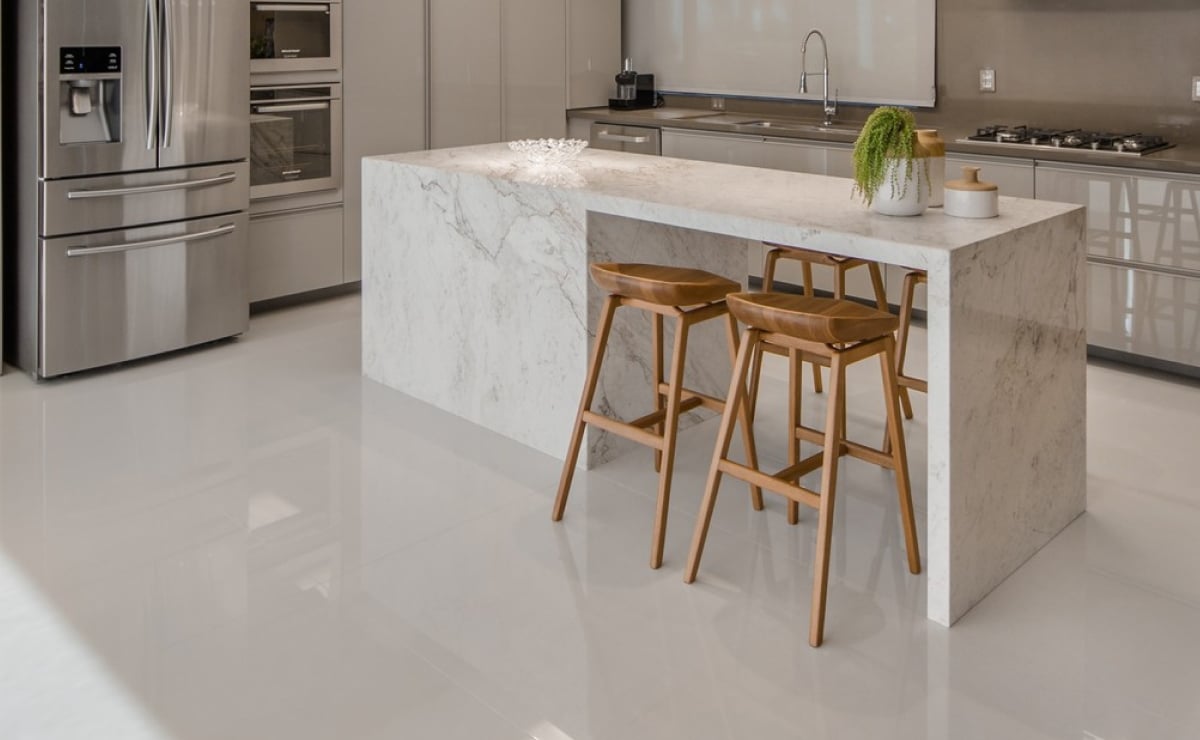
There are several types of floors, so they cannot be cleaned in the same way. Each material deserves special attention and needs specific care. However, in all cases the cleaning should start the same way: collecting all the dust and dirt accumulated on the floor with a soft-bristled broom. Only after that can your floor receive a treatment to remove stains and recoverthe glow.
1. slate
The main problem with porous stones is their high absorption power, which can cause stains to appear over time. Slate is not so porous, but even so it cannot withstand very concentrated products, so care must be taken when cleaning.
The personal organizer Juliana Faria says that the first step in cleaning this type of floor is to remove the dirt: "Use a soft broom or a vacuum cleaner, then make a solution of water with neutral detergent: for every 5 liters of water, add 1 tablespoon of neutral detergent. Spend it on the floor with a soft cloth or a mop", she teaches.
If you want a shiny floor, a good tip is to add three spoons of white vinegar to the mixture of water and neutral detergent. Juliana also says that it is possible to do waterproofing, which is a procedure that prevents water from accumulating under the floor. It will also prevent water from infiltrating the structure of the property, which can result in very expensive damage toBut attention, "do not use abrasive products, steel sponges, pumice stone, or brushes with hard bristles to avoid the risk of scratching the surface," warns Juliana.
2. carpet
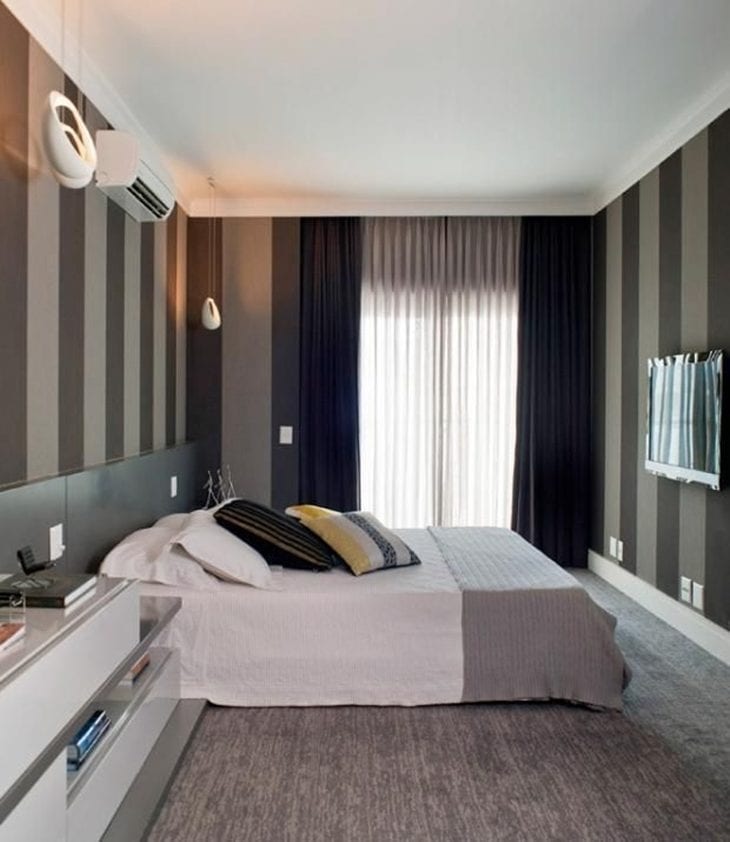
Carpet cleaning consists basically of using a damp cloth and a vacuum cleaner. Avoid using too much water, as it can cause mold. For people with allergies, this type of covering deserves special attention, since dust accumulation is greater, and cleaning must be frequent.
The personal organizer explains how carpet cleaning should be done: "vacuum at least three times a week and use a vacuum cleaner with good suction and a smooth nozzle, without scrubbing too much. Serrated or rough nozzles can damage the carpet's surface, unraveling the yarn. Every month or when the carpet looks dirty and dull, wipe it with a clean, damp white clothon the entire surface, drying with another white cloth afterwards.
Juliana also advises you to always test the cleaning products on a small area of the carpet before using them, so you don't run the risk of damaging or staining this type of floor. In addition, carpet is also not recommended for people with pets, because of the accumulation of hair.
If your carpet is stained, Juliana warns that regardless of the nature of the stain, it should be removed as soon as possible to avoid the penetration and fixation of the product that stained the carpet.stain, remove as much of the product that fell on the carpet as possible with a spatula or absorbent paper.
For those who like a good homemade recipe, Juliana indicates the following formula: in 1 liter of warm water, dissolve 1 tablespoon of neutral detergent and 1 tablespoon of white vinegar. Shake well to form a foam. Spread the foam with circular movements and leave it for a few minutes. Lightly scrub the stained area with a sponge or clean cloth, wetting the carpet as little as possible.
Important: Wipe the area several times with a damp cloth to remove all foam residue from the detergent applied to the carpet. Drying must always be done with a clean white cloth.
3. burnt cement

Although it is a durable floor, simple to clean and resistant to impacts, some practices are necessary to keep it in good condition and avoid its long-term wear.
For cleaning, Juliana recommends again removing the dirt, such as dust and sand, with a soft hair broom or vacuum cleaner. When washing the floor, just use neutral detergent, warm water, a clean cloth or cleaning brush. The surface should never get wet, because other dirt can stick.
In cases of stains, an alternative is to sand the surface of the burnt cement very carefully with fine sandpaper. This must be done very carefully, so as not to damage or uneven the floor. In addition, it is important to avoid using abrasive products, as they can cause scratches that are difficult to remove, and also acid products, which damage and take the shine off the surfaces.
To maintain durability, a good option is the treatment with acrylic or water-based resins, which reduce the porosity of the surface and prevent the absorption of fungi and dirt. Before applying the resin, it is recommended to apply a protective base with the help of a roller, brush, or gun. It is recommended to apply the resin in two coats, respecting a 12-hour interval between them. The maintenance ofresin should be done every three years.
For those who want to keep the floor shiny and prefer a more economical option, a good alternative is to use wax or even varnish, applied weekly.
4. cork
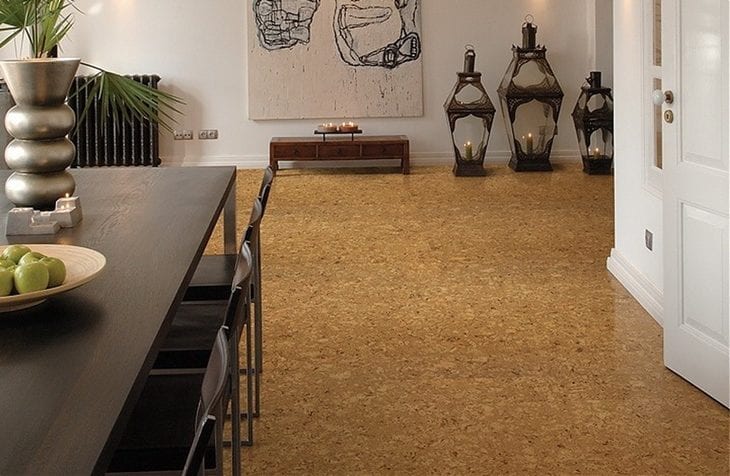
The cork floors are sustainable and have a higher resistance to fungi and bacteria. As with most floors, the recommendation for cleaning is the same: water solution with neutral detergent and application through a soft cloth.
However, even so, it is necessary to keep in mind that the cleaning of cork also depends on its insulation. Some floors have a protective and waterproofing top layer, while others are not installed this way. Pay attention to the specific care for each case:
Waterproofed : If the floor is well waterproofed and can tolerate some humidity, then it is safe to clean it with water. In this case, fill a bucket with clean water and then add neutral detergent. Juliana always recommends the proportion of 1 tablespoon of neutral detergent to 5 liters of water. Dip a mop in the water with detergent and squeeze out the excess. Even in cases where the floor is well insulated,The less water the better. Clean the floor normally. Then use a clean cloth to dry it or let it air dry. If you prefer, you can choose to clean it with specific products for this type of floor. Always look for a specialized store and make sure that the cleaning product will not damage the cork insulation.
Not waterproofed In this case, the best strategy is not to use water and liquid detergents. You can use a soft rubber sponge, a soft broom or a vacuum cleaner to remove dust and other loose dirt. If you choose the vacuum cleaner, be careful to handle it gently and without scratching the floor. In the most affected places with ingrained dirt, apply a clean, slightly damp cloth andThen wipe the floor with a clean, dry cloth to remove all traces of water and moisture. Repeat these last two steps until it is completely clean. Let the floor air dry.
Most of the time, the manufacturer puts a special protective layer on this type of flooring, which prevents stains and reduces day-to-day wear to a minimum. However, to maintain the durability of the cork floor, it is also possible to wax it with some regularity. Just pay attention and always use the appropriate wax to avoid the risk of damaging the floor. It is also necessary to haveBe careful with very heavy furniture on the surface and even with pets.
5. rubberized

This is a very versatile floor, the rubber floor board can be found in different models, colors, and even simulating wood. Cleaning this floor is very easy and also requires only a damp cloth and neutral detergent. To remove dirt accumulation, give preference to clean, lint-free floor cloths.
Use neutral detergent, which can be diluted in either warm or cold water, again in the proportion recommended by Juliana, 1 tablespoon to 5 liters of water, and mix until foam forms. Apply the product over the entire floor and spread it with the help of a broom.Then start rubbing the surface with circular movements.
When you are done, rinse with water and remove all the soap. To finish, dry the entire floor with the help of a dry, soft cloth or flannel. It is recommended that you dry the floor well so that dirt and dust that may be present in other rooms does not accumulate or stick to it.
You can also use a disinfectant to complete the sanitizing and restore the shine. In addition, you can also use vinegar, which helps restore the shiny appearance and also works to eliminate unpleasant odors. If you don't like the characteristic smell of vinegar, you can dilute some of the product in a bucket of soapy water.
Cristiane Ayres, manager of the P&DP department of the cleaning products brand Casa KM, recommends some products of the brand for this type of floor: "For a general and light cleaning, dilute ½ cup (100ml) of Casa & Perfume in 3 liters of water. Moisten the cloth and apply on the surfaces to be cleaned". For heavy cleaning, Cristiane recommends applying the product pure with a squeegee andIn addition, she warns: "never use solvents/ removers and do not apply wax, as it cannot be removed.
To keep it clean, broom two or three times a week. In areas with heavy traffic, more maintenance is needed. In these cases, use a damp cloth with a non bleach multipurpose cleaner or any product for cleaning non-slip floors.
6. granilite
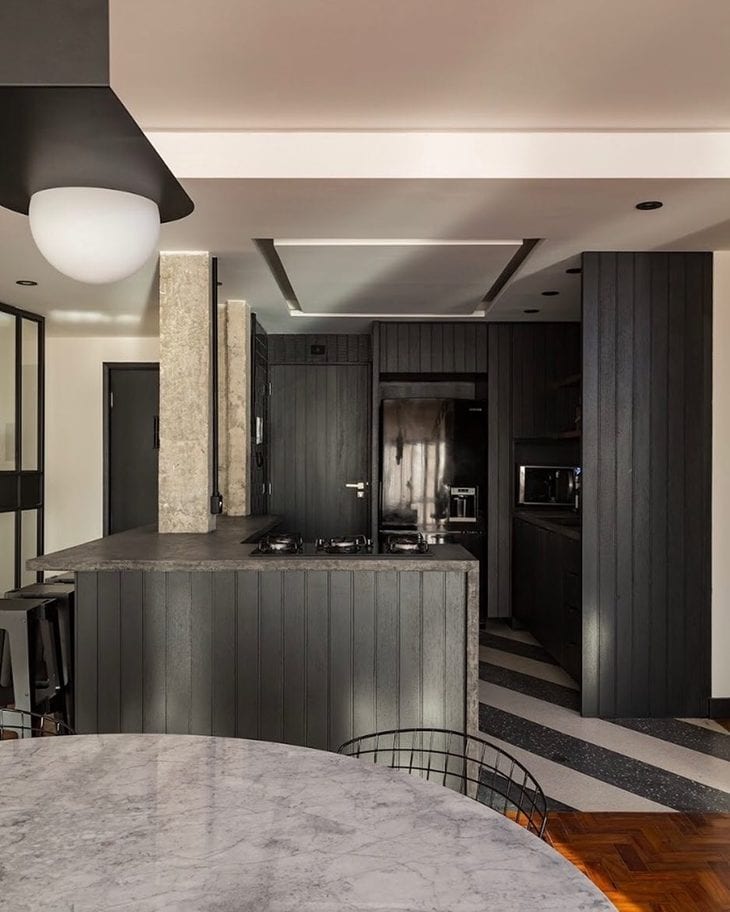
Granite is a differentiated stone that is composed of a mixture of materials such as marble, granite, quartz, and limestone, which can be mixed or not, as well as cement, sand, and water.
The floor of this material is very durable and the cleaning is no different from most. First of all, we should sweep it and, if possible, vacuum the excess dust and debris. After this procedure, we can start the washing part. Wash the entire floor with the same solution of water and neutral detergent, as previously recommended, using a soft cloth or mop. After cleaning, rinseall floors with clean water.
Two types of granilite can be found in the market, the polished and the fugê, which are differentiated by their texture. The first receives a smooth finish and a layer of resin, and the second keeps the relief of pebbles. It is important to point out that polished granilite, when wet, becomes very slippery due to its resin, so after washing, dry it immediately.
In this case, Cristiane Ayres recommends: "do not use acids, chlorine products or abrasive agents, as they can damage the floor surface.
7. granite

The floor coated with this noble rock is also very durable, has low water absorption, and is stain resistant. The biggest problem with granite is that it can be easily damaged by conventional cleaning products, so it is worth taking care to ensure that the floor is always clean and shiny.
To avoid mistakes when washing, use once again a solution of water and neutral detergent. You can also opt for specific products for this surface, which are those with neutral pH. Use cold water. In addition, "use waterproofing material once a year to make cleaning easier and avoid stains", Juliana recommends.
Besides conventional cleaning products, do not use hard objects, such as wire mops, or products to clean ceramic floors, because they can take the shine off this surface. Acid or alkaline solutions, such as vinegar, are also forbidden for this floor.
Special Tips:
- In the case of stains, rub the area lightly in the direction of the grain. Do not make circular movements, as this will damage the floor.
- Use a microfiber cloth to dry and shine the floor. Never let it dry naturally to avoid water marks.
- Avoid using a vacuum cleaner on your granite floor, as it can scratch it.
- It is recommended to place a rug at the entrance of rooms that have granite floors.
- If you use objects on the floor, such as vases, for example, place them on a rubber mat so that they do not come into direct contact with the floor.
- If you want to further prevent possible damage and scratches, you can apply a protective coating to the floor.
8. tile or hydraulic tile

Hydraulic tile floors are made by hand and cure for about eight hours under water, making them durable and easy to walk on, not to mention easy to maintain.
Although it is resistant, it is also a very porous material, so it must be cleaned and treated with care. Once again Juliana's infallible little recipe should be used. Remove loose dirt and dust using a hair broom, then clean with water and detergent or mild soap.water stains and also that the dust present in the room sticks to the finish.
Every 20 to 15 days, you should apply a specific wax for hydraulic tiles or colorless liquid, applied with the help of a squeegee and a flannel. This helps reinforce the protection and polish the floor, restoring its natural shine. Another option is to rub a fine sandpaper with a little water on the spot that is dull or to use a descaling agent, using an industrial wax machine.
Avoid abrasive cleaners and, to avoid scratching the finish, use a soft sponge. Wipe up any liquid spills immediately and avoid dragging furniture or metal parts.
The tiles, on the other hand, are types of tiles that, over time, end up getting dirty, wearing out, and losing their shine more easily, because they have a great capacity to retain residues. It is recommended to clean them on average every 15 to 30 days. You can use the same products and recommendations as for the hydraulic tile.
9. demolition wood
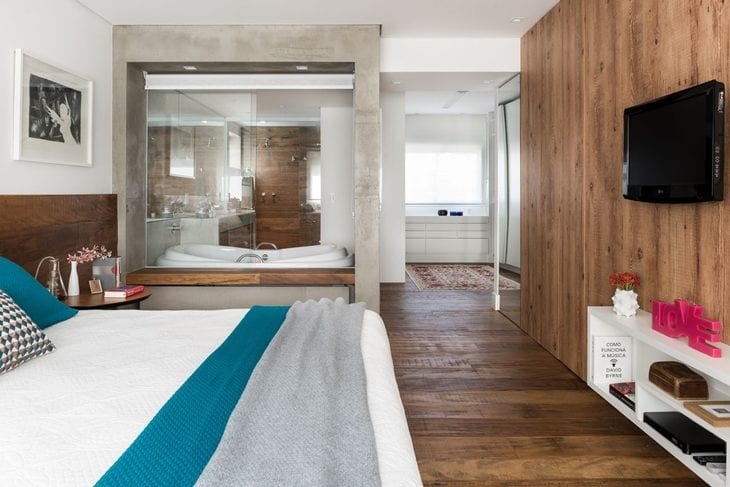
The demolition wood floors are floors made of noble woods of very high durability. Normally high quality woods are used, such as Peroba Rosa, Ipê, Jatobá, and Jacarandá, for example.
Juliana recommends the same cleaning process again: soft brooms to remove loose dirt and a solution of water and detergent for washing, always using a damp cloth. But, for this floor, she gives special advice: "wring the cloth very well, because wood can absorb water. Excess water can lead to swelling of the surface.
As this floor is more rustic, then the stains that it gets over time end up making the wood even more charming, i.e., it lessens the concern with a heavy cleaning routine.
If you want tips on specific cleaning products for wood, Cristiane, from Casa KM, indicates: "if the wood is coated with a non-acrylic waterproofer, use the perfumed cleaner Casa & Perfume. For heavy cleaning, apply the product pure with a damp cloth and squeegee. For light cleaning, dilute ½ cup (100ml) of Casa & Perfume in 3 liters of water. Moisten the cloth andNow, if you want to enhance the shine, use Shine Easy Special Care. Apply the product directly on a damp or dry cloth and spread it evenly with a squeegee. Let it dry. Remember not to apply too much.
Cristiane also says to avoid products that make the wood too humid, especially if it is not waterproofed, because it can absorb them and thus stain and even rot.
Other than that, the recommendations are simple: never use industrial waxes and oils that can be found in supermarkets. They can stain and will certainly alter the original color of the floor. Maintenance can be done monthly with a very light sanding with a steel sponge and application of natural varnish or pure carnauba wax. Remove the excess two hours after application. This wax can befound in woodworking stores, but supermarkets have a flooring paste made from carnauba, which can also be used.
10. hardwood

Hardwoods are heavier and stronger, besides being rigid and impermeable. For this reason, their main advantage is greater resistance to temperature variations and natural pest infestations. It can be used in the format of parquet flooring, parquet blocks, and planks.
The cleaning rules do not differ from those of demolition wood, so follow the same steps already explained. For treatment and durability, a considerable advantage of this type of flooring is the possibility of scraping to renew the surface and recover its appearance. However, since natural wood is porous, after sanding, it is exposed and it is necessary to seal it with resin, wax orvarnish.
If you choose varnish, the options are mirrored, semi-gloss, and matte floors. But before choosing the varnish, talk to a specialist to find out the best option for the conditions of your house. You can also look for specialized companies that apply synthetic to leave the floor brand new again. It is ideal for the case of old, loose, and peeling boards and parquet.
If you choose wax, the best option is paste, because applying liquid wax on the sanded wood floor can stain the pieces. Also, colored waxes are terrible for maintaining any kind of floor, because they can create terrible stains, so always opt for colorless wax. Colorless natural wax in paste is also a good solution to protect the floor from humidity.
11. tablets

Glass tiles are often used on walls, but they also look great on the floor. However, to ensure the beautiful look of the coating, it is necessary to keep the pieces clean at all times.
Before talking about routine cleaning, it is important to talk about post-work cleaning, that is, the first cleaning of the floor. Before you start cleaning, let the grout dry for at least 30 minutes. In this first wash, try to remove the excess grout using a soft, clean, damp sponge. Do it very carefully, because some abrasive materials, such as cement and sand, canFinish with a clean, dry cloth.
After tile application, it is recommended to use a grouting additive. This product creates a protective film that helps protect against the proliferation of mold and mildew.
For routine cleaning, deep cleaning is not necessary, because tiles do not absorb as easily as ordinary flooring, so the coating does not stain or fade, but daily cleaning helps to keep the tiles shining brighter.tessellation starts to fade or to form mold in the grouting.
About the best products for washing, the solution with water and neutral detergent is always the best option for all types of floors.steel, brooms, or any other product that has steel in its composition, as they can scratch, damage, or remove the shine from this type of flooring.
Another tip is to always keep the environments with tessellation flooring ventilated, especially bathrooms and kitchens. The constant air circulation helps to dissipate humidity and grease.
12. ceramic floor

In most cases, a damp cloth, detergent, and water are enough to remove the dirt. Gislane Pereira, customer service supervisor at Cerâmica Portinari explains how the right cleaning must be done for each variation of this floor:
"The satin and polished floors should be cleaned with a soft bristled broom or a vacuum cleaner. For the finishing touch, just a damp cloth with neutral detergent is enough. The non-slip floors, on the other hand, should be cleaned with a hard bristled broom. For washing, a powder soap can be used, or even a pressure washer (jet)", she says. For the bathroom, a place ofAlways dry the floor after cleaning.
According to Gislane, "the best product for satin and polished floors is neutral detergent. For the removal of some deeper dirt, you can use creamy soap". Attention also to the products that cannot be used. Powder soap is not indicated because it forms a film that leaves the floor blurred. Besides this, never use acids or steel wool, because they cause stains.
Special Tips:
To clean up grout residue: in post-work cases, grout residue can stick to the ceramic floor. to remove it, use soapy water and scrub with a stiff sponge. then apply white vinegar diluted in water and leave it for a few minutes before scrubbing again.
For removing paint and rust stains: Make a mixture of bleach and soapy water.
For removing stains from juice, tea, and coffee: Clean with detergent and hot water, followed by hydrogen peroxide.
To clean grease: Grease can be cleaned with baking soda diluted in water.
Extra care: Ceramic tile floors can become scratched when furniture or metals are dragged over them. In many cases, the glaze that coats the floor is friction resistant, but it can still become marked. The glaze that makes ceramic tile smooth is also very similar to glass, so it can chip or crack if struck by sharp objects or projected with great force. Therefore, it is best toplace protection under the feet of the furniture.
13. marble floor

Marble floors are beautiful and elegant, but demand extra attention. This material is very porous and has a high absorption capacity. Therefore, "do not use concentrated, corrosive or greasy products such as acids, solvents, alcohol, chlorine, soap powder, kerosene, soaps, bleach and abrasive materials", reinforces Juliana.
In addition to cleaning products, the biggest enemies of this coating are oils and fats, so be very careful not to spill food and cosmetics on the marble floor. You must also be careful with acid liquids in general, such as lemon juice and vinegar, as they can corrode the surface. Double attention also with coffee, wine, cans, nails and water in abundance, as they cause stains andIn the case of spilled fluids, it is best to wipe them up immediately with absorbent paper.
The recommendations for cleaning marble are basically the same as for granite. Daily cleaning should be done with a mop or cotton cloth dampened in a solution of 1 tablespoon of neutral detergent, neutral soap, or coconut soap diluted in 5 liters of water. After this procedure, rinse with a wet cloth well wrung out and finish by drying with a soft cloth.
For maintenance, it is recommended to sweep the floor with a soft broom and vacuum frequently, because the dust settles easily on its porous surfaces only with the pressure of people walking on the floor. Another tip is to wax the floor after cleaning it with colorless liquid wax. To do this, use a soft cloth and then a flannel to polish it.
14. laminate flooring
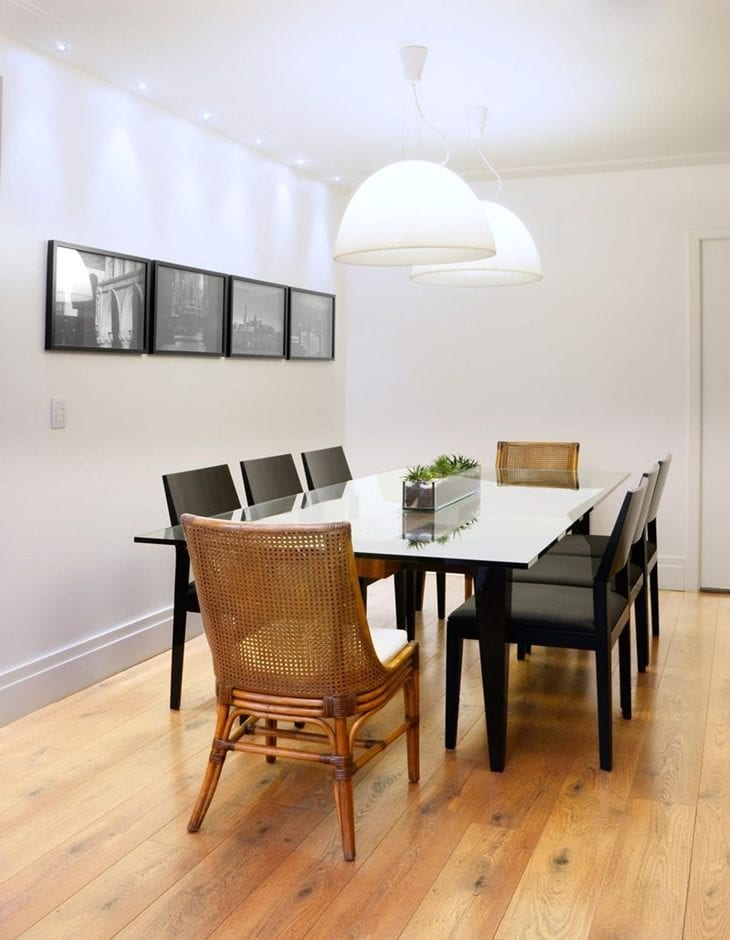
Laminate flooring is made from particleboard, and the most important detail for cleaning this type of material is that it cannot be washed. Contact with water and also direct sunlight on the floor can deform the pieces.
According to Renata Braga, product manager at Duratex, responsible for the Durafloor brand of laminate flooring, cleaning this type of flooring is very simple and quick.In kitchens, protect the laminate floor by preventing water from coming into contact with it. Never wash the laminate floor", he explains.
To remove stains, Renata advises that there are specific indications for each use: "for shoe polish, grape juice, wine, coffee, soda, lipstick, mercury, nail polish and enamel paint, cleaning with detergent and alcohol is recommended. Alcohol is also effective for removing stains from ballpoint pen, modeling clay and atomic brush. If your problem is caused byTo remove glue, the ideal is to use nail polish remover. In case of other resistant residues, a clean cloth lightly dampened with nail polish remover can also be used. This simple solution solves most of the cases".
Another important recommendation is in relation to the products used for cleaning. For daily cleaning, it is enough to use neutral detergent diluted in water. However, for a specialized cleaning, Renata suggests: "we recommend the Destac® Laminate Flooring Cleaner, by Reckitt Benckiser, which must be applied directly on a dry cloth and always passed in the direction of the floor texture (length of the rulers)".See this product and other suggestions below.
And attention, never pass wax on laminate flooring: "Over time, it tends to stain Durafloor, because the layer that covers the surface of the floor is impermeable (it does not have porosity). Therefore, if any kind of wax is applied to the surface of the product, it will not be absorbed, besides making it extremely slippery. This goes for both liquid and paste wax", explainsexpert.
In case you have already applied wax without knowing it, the recommendation is to use a remover: "You can use the remover that the wax manufacturer indicates, K&M remover or the English wax remover, but it is not guaranteed that the wax will be completely removed and that the floor will return to its previous characteristics", warns Renata.
In addition, never use sharp or abrasive materials, electric floor polishers, steel sponges, sandpaper, or silicone-based products, because they create a greasy layer that damages the floor and makes the next cleanings more difficult. To keep the cleaning, durability, and shine of this floor, pay attention to these tips:
- A doormat or the equivalent is recommended at direct entrances from the street to trap stone particles and dirt.
- If you need to move furniture, protect the feet and bases with felt or rubber to prevent scratches and stains. If you need to move heavy furniture, cover it with cloths, pieces of padding, or carpeting to prevent friction.
- Be careful with chairs with casters, they scratch the resin film of natural wood and the surface of laminates. In specialized stores, you can find protectors for them. For other furniture with casters, the recommendation is to replace the nylon ones with polyurethane.
- Avoid stepping in stilettos with metal fasteners.
- Do not allow the floor to be exposed to rain through windows, doors or dripping water. If this occurs, immediately arrange for it to dry. Also protect the floor from the sun's rays by using blinds or curtains.
- If you are going to do some construction work at home, cover your laminate floor with cardboard so as not to cause scratches.
15. vinyl flooring

Vinyl flooring is very similar to laminate and wood, is very resistant, and, in addition, is produced with recyclable materials. Therefore, just like the two floors mentioned above, cleaning should also avoid water and should be done only with a damp cloth.
The manager of Tarkett, a company specialized in vinyl flooring, Bianca Tognollo, guides the cleaning process for the two types of this type of flooring: glued vinyl flooring and click vinyl flooring, which are those that are applied by a fitting system.
"The cleaning of the glued vinyl floor should only be carried out seven days after installation, since this is the period when the adhesive cures. Remove the dirt from the floor (sand or dust) with a broom or dust mop and apply a solution of water with neutral detergent to the entire floor, using a water mop or cleaning machine (red or green disk). Rinse using a squeegee and a clean cloth or water mop. Use the minimumas much water as possible and allow the floor to dry completely before releasing it for use," she explains.
In the case of click vinyl flooring, Bianca says that cleaning can be done immediately after installation. Just use a damp cloth and neutral detergent and, to rinse it off, wipe it with a clean damp cloth. In addition, for both cases, if the environment is still under construction, remember to protect the floor with bubble wrap or tarpaulin.
She also warns about the cleaning products that should be avoided for this type of floor: "products that damage the surface of the floor, such as abrasive brushes and sponges, chemicals such as bleach, removers, turpentine, etc. Many vinyl floors do not require the use of wax, but if you want to make the floor shinier, we recommend the use of acrylic wax, which promotes the shineand does not need a waxing machine".
16. porcelain tile

The porcelain tile needs some special care when it comes to cleaning to ensure that its beauty lasts longer. After the job is finished, it is extremely important to perform the first cleaning; it is this that will give the coating shine and prevent superficial stains from appearing in the first years. In addition, when well executed, it will also make daily cleaning easier.
Using a soft, dry cloth, start by removing the haze, which is the superficial film formed on the coating. The cleaning and finishing should be done no more than 30 minutes after application, using a sponge dampened with clean water. Then, apply a post-work cleaning detergent, which can be found at the main construction materials stores. ItThis product can also be used in extreme cases, such as hard-to-remove stains.
For daily cleaning, sweep the floor with a soft bristled broom and then wipe it with a wet cloth. Gislane Pereira, from Cerâmica Portinari, also gives guidelines for the porcelain tile: "we always recommend neutral detergent and soap. For polished ones, a cloth with alcohol can be used. The shine of porcelain tiles does not change over time. With the correct maintenance, it will keep its shine.After washing, dry with a clean cloth.
For more effectiveness, Gislaine indicates the two-bucket technique. Learn the step-by-step:
- In the first bucket, put clean water and neutral detergent.
- In the second bucket, put only clean water.
- Remove loose debris with a broom or vacuum cleaner.
- Take a clean cloth and dip it in the first bucket, then apply it to the coating and leave it for three to five minutes.
- Rinse the cloth in the second bucket and wring it out well.
- Wipe the coating with the cloth to remove excess detergent.
- To finish, wipe with a clean cloth.
You can also use vinegar, always diluted in water, since it does not stain, does not diminish the shine, and is harmless to the porcelain tile.
To clean the porcelain tile in a heavy way, "use a creamy soap diluted in water. The dilution must be one part of the product to 9 parts of water. The non-dilution of the products, as well as their direct application on the floor, can cause the appearance of permanent stains. After cleaning, rinse well with clean water only and dry with a clean cloth", explains personal organizer JulianaFaria.
Juliana also talks about the products that harm this type of floor: "do not use waxes or waterproofing products, nor products that contain fluorine and its derivatives, especially hydrofluoric acid. Never use soap powder, brushes, acids, bleach or caustic soda on the pieces. Steel wool or similar products are not indicated, since they can scratch, damage and remove theshine of the porcelain tile or enamel coating".
The use of non-indicated products can cause a chemical attack, leaving the surface porous and favoring the appearance of stains, scratches and opacity on the floor. Gislaine reinforces this concern: "products that contain acid in their composition or a skull design on the label cannot be used. These products chemically attack the porcelain tile, causing irreversible stains to the floor.over time.
Cristiane suggests products from Casa KM that are specific for this type of floor and that provide a perfumed and shiny cleaning: "use Brilho Fácil Cuidados Especiais, a cleaner for porcelain tiles and ceramic floors. Apply the product pure on a clean and dry cloth, do not dilute. Spread it evenly over the floor, using a squeegee and let it dry. Do not apply in excess". ButAttention, the specialist advises not to mix the products with other cleaners and not to apply them directly on the floor. Always follow the recommendations of the floor manufacturer.
See_also: 15th Anniversary party decoration: 88 pictures with ideas and tutorials to inspire youSpecial Tips:
For removing stains from paint, enamel, pens, and other types of pigments: During construction or home remodeling, the porcelain tile can get paint splashes. To remove them, the indicated is to use an organic solvent. Do not leave the product acting for a long time on the floor.
To make the environment smell better: neutral detergent diluted in water does not leave the house with a clean smell, so after you clean the floor with this solution, use a room scent spray. Just be careful not to spray it directly on the floor.
17. liquid porcelain tiles

Liquid Porcelain tiles is the name given to monolithic floors, that is, with a homogeneous and seamless appearance, made with resin and with a shiny final aspect. The first cleaning must be done only 24 hours after the floor has been installed.
Routine cleaning also follows the basic rule of a soft broom to remove loose dirt and dust, and then a damp cloth with a solution of neutral detergent diluted in water.
For greater durability, avoid dragging furniture and heavy objects on the floor, and always protect the feet with felt adhesives. If the floor cracks, insulate the damaged part, collect the chipped material and request a visit from specialized companies. In addition, the natural wear of the floor may require a new application in the area. It is very important to make revisions within the periodicity recommended bysupplier.
18. epoxy resin
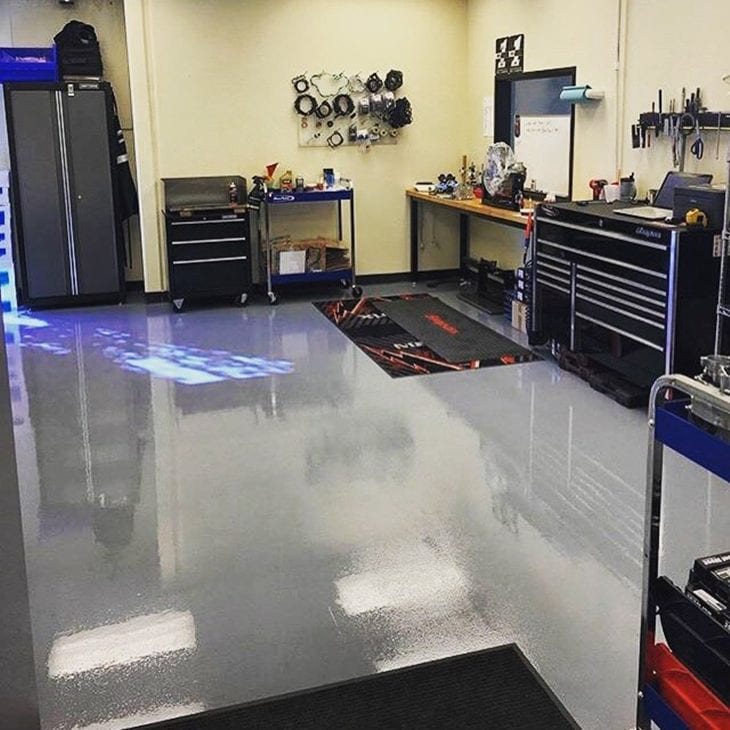
Epoxy resin is a liquid applied to the floor and spread with a kind of squeegee, forming a layer that automatically levels itself out on the surface. This flooring is also known as self-leveling flooring. It has greater chemical resistance, is waterproof and does not absorb dirt. However, it is not very resistant to scratching, thermal shock and expansion, and is at greater risk of cracking. Therefore,Avoid dragging and leaning very heavy materials on the floor, as this can cause cracking.
See_also: 100 amazing modern house fronts to inspire your projectCleaning is very similar to that of liquid porcelain tile and, just like it, the first cleaning must be done within 24 hours after installation. For daily cleaning, use a soft-bristled broom or a blue dust mop, and preferably use neutral detergents.
For heavy cleaning you can mop the floor with a microfiber foam mop, hot water and clear ammonia. Four to five drops of ammonia per gallon of water is recommended. It is important to sweep before mopping the floor to prevent damage to the epoxy, as harder debris can scratch the floor.
If you can't remove the dirt with hot water, use neutral degreasers. Don't use chemical cleaners that are abrasive, acidic (include citrus and vinegar) or alkaline, such as soap and bleach. Don't use soap-based cleaners either, as they leave residue on the floor that damages the shine and also makes it more slippery.
In case of spills of juices, soft drinks and liquid foods in general, or drops of oils from vehicles, wipe it up with a paper towel or other soft cloth. If you prefer, moisten the cloth to make it easier to clean. This way you will avoid damage to your floor.
19. silestone

This type of stone is durable and widely used as table tops and kitchen countertops, but can also be used for flooring. If you have silestone on the floor of your house, repeat the classic cleaning procedure recommended by Juliana: remove the dirt with a soft bristle broom or vacuum cleaner. Then make a solution of water with neutral detergent. For every 5 liters of waterPut 1 tablespoon of neutral detergent on the floor and wipe it with a soft cloth or a mop.
Another alternative is to moisten a cloth with warm water and apply glass cleaner to the floor.
Special Tips:
- Do not use water repellents or sealants to enhance the shine. These products provide an artificial and temporary shine.
- Do not use paint strippers, caustic soda, or products with a pH higher than 10.
- If you choose to use bleach, rinse with plenty of water. Never leave this product in permanent contact with the floor.
20. glass
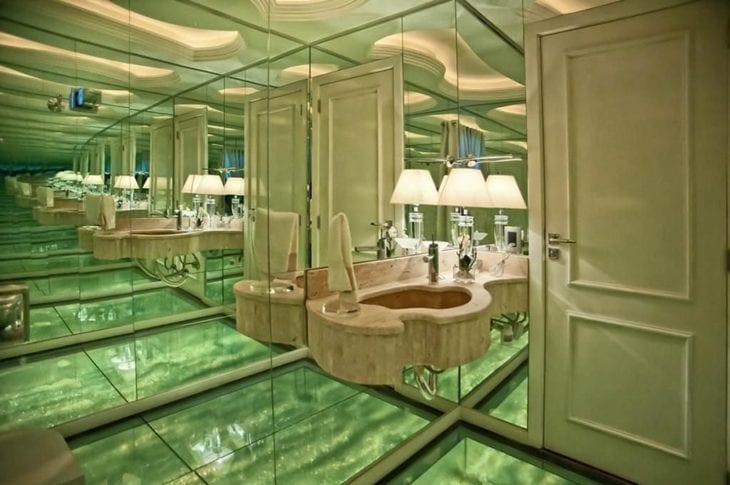
Glass flooring should be cared for in the same way as other glass surfaces, such as windows and doors. Do the same procedure as for other floors for light cleaning. Remove the dirt with a soft bristle broom and then make a solution of water and neutral detergent. Wipe the floor with a soft cloth or mop.
To combat the stains that make the glass foggy and dull, make a mixture of detergent and white vinegar in a 1:1 ratio. Dip a sponge in the mixture and then wipe the floor without pressing, to form enough foam. Leave it for four minutes, rinse well and dry with a microfiber cloth, because cotton towels leave lint scattered. To avoid even more stains, try to spendFor better maintenance, you can perform this procedure monthly. Avoid using products with ammonia, chlorine or bleach.
Another homemade recipe option is to mix 300ml of alcohol 70 with 300ml of filtered water and a tablespoon of white vinegar.
Although this flooring uses well-reinforced glass, be very careful when leaning furniture and heavy objects on it, as you risk cracking or even splitting the surface. Don't drag furniture and protect the bases with felt.
Classic cleaning problems
Now that you have learned how to clean each type of floor correctly, it is important to pay attention to other problems that can create doubts when cleaning: grimy white floors and cleaning grout. Find out what to do in each case:
Grimy white floor

Having that white, shiny and clean floor at home is all good, not to mention the peaceful feeling it brings to the environment. But as not everything in life is flowers, this beautiful floor can become grimy over time and lose all its charm. But don't be alarmed, this problem has a solution.
Juliana Faria, personal oganizer, recommends how to proceed: "try to clean it by soaking it in water and neutral detergent. If the dirt does not come out, use a specific product for your type of floor. Depending on the state of the dirt, the best thing to do is to go to a company that specializes in cleaning floors. Remember that once the floor is damaged after using the wrong product, there is no morereturn."
If you still want to try one more homemade recipe before going for the chemical products, Gislaine Pereira, from Cerâmica Portinari, suggests: "you can always use bleach diluted in a 3 to 1 ratio - 3 parts water to one part bleach. Leave it for 15 minutes and rinse with clean water".
Starting for the floor cleaner: in the market there is a great variety of these products that can help remove the grimy from the floor. But always remember to read the packaging carefully to find out which is the most appropriate and follow the instructions for use. In this case, "use the pure product, because the actives will be more concentrated, presenting a greater cleaning power", explains Cristiane Ayres, managerof the KM House brand.
But beware, to avoid the formation of stains that are difficult to remove, make sure that the cleaning agent you have chosen is not too concentrated, and avoid using alcohol-based products.
White grouting
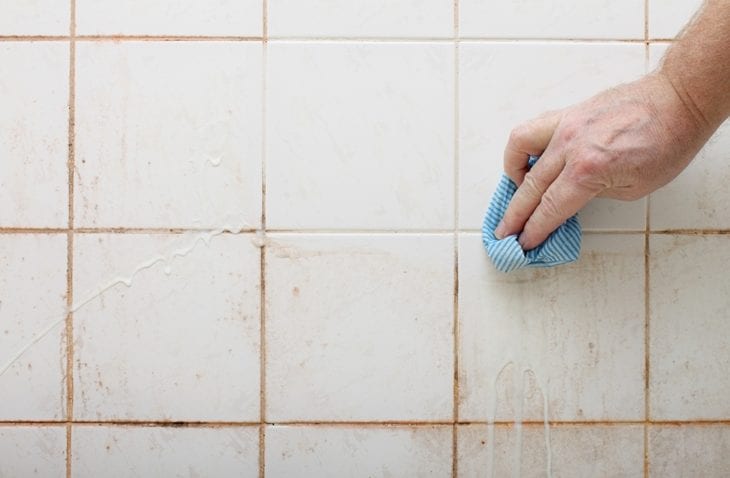
The grouts also deserve special attention. They are porous, so dirt will inevitably accumulate. If they are not cleaned frequently, this dirt can become very concentrated and impregnated, creating a lot of headaches when it comes to cleaning. The best thing to do is not to let it get gray by scrubbing every week or whenever you notice that the grout is starting to darken.
"Alcohol vinegar is very good for cleaning white grout. Before applying it all over the floor, make a test on a more hidden area to see if the vinegar does not create any kind of stain. Put a good amount of pure alcohol vinegar on the grout, leave it to act for 30 minutes and then scrub it with a small brush. Do not let it dry. Wash the floor or wipe it with a cloth dampened with water and detergentIn the market there are also specific products to clean grout. Read the label carefully to make sure it is suitable for your type of floor", explains Juliana.
You can also use creamy soap to clean the grout, but always choose the liquid version, which is much less abrasive than the powder version. To do this, apply the pure product on the grout, leave it to act for ten minutes and then clean it with a sponge, using the yellow side, which is softer. To be sure that the soap will not stain the floor, dilute the product in water and test onYou can also use diluted bleach, let it act for 15 minutes and rinse it", reminds Gislane.
Suggestions for specific floor cleaning products
We have separated a list of specific floor cleaning products to help you with the cleaning of your home. Check it out!
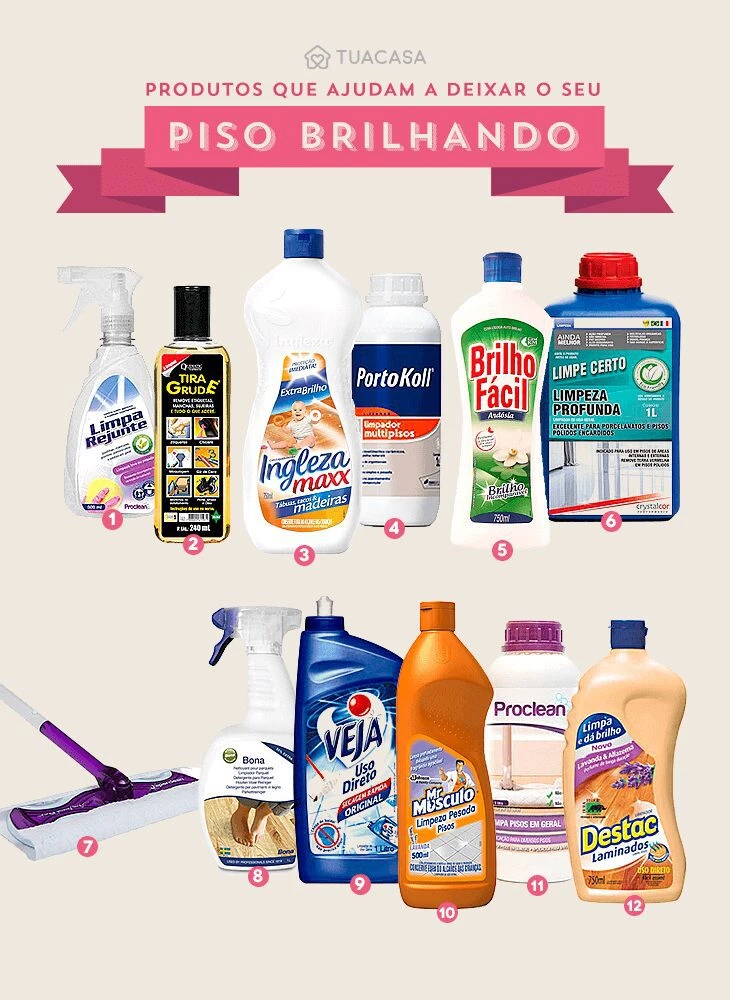
Product 1: Proclean Grout Cleaner 500ml - Buy at Americanas.
Product 2: Tapmatic Grout Remover 40ml Buy at Telhanorte.
Product 3: Ingleza Max Special Liquid Woodwax 750ml Buy at Net Suprimentos.
Product 4: Post-Work Cleaning Detergent 1 liter Cleanmax Portokoll. Buy it at Extra.
Product 5: Liquid Slate Wax 750ml Easy Shine, Buy at Cepel.
Product 6: Limpe Certo Deep Clean Porcelain Tile and Grimy Floor 1 Liter Performance Eco Buy at R3PShop.
Product 7: Hiperclean Broom and Squeegee Applicator Kit Buy at Walmart.
Product 8: Bona Care Wood Floor Cleaner 1 Liter Bona Buy at Americanas.
Product 9: Reckitt Dilutable Heavy Cleaning Concentrate 1 liter. Buy it at Kalunga.
Product 10: Mr Musculo Heavy Floor Cleaner Lavender 500ml Buy at Casa Fiesta.
Product 11: Proclean Marble and Granite Cleaner 1 liter - Buy at Submarino.
Product 12: Direct use laminate floor cleaner 750ml Destac Reckitt Buy at Kalunga.
Knowing the right way to clean each material is essential to keep the floor clean without damaging its properties, and you won't have to spend money on frequent renovations and restorations.


